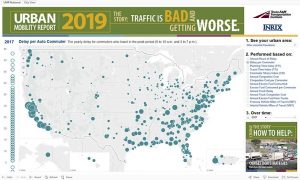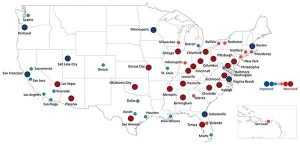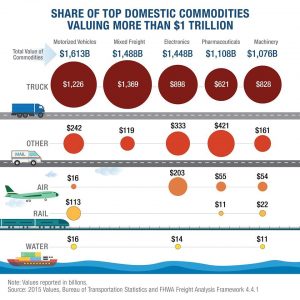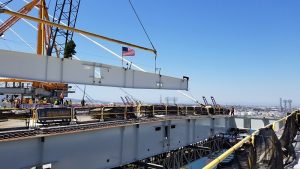 Photo: Texas Transportation Institute
Photo: Texas Transportation Institute
“During the years of the conservative era (the Reagan-Bush Administrations), the national infrastructure was allowed to deteriorate to an unprecedented degree. According to the figures of the Office of Management and Budget, federal investment in public capital was cut by a third from 1976 to 1990; education and training by almost 40 percent; physical capital by almost 30 percent; research and development by the same. Economist David Alan Aschauer, to whose research we owe the first full-scale airing of the problem, has estimated that total non-military public investment in the 1980’s was only half that of the previous decade and only one-fourth of the level of the 1950’s and 1960’s. In fact, public investment has been neglected to such an extent that, according to Aschauers estimates, a dollar spent in the public sector raised GNP by considerably more than a dollar spent for private investment.”– Robert Heilbroner and Aaron Singer, The Economic Transformation Of America: 1600 to the Present [1]
By Stas Margaronis
The Covid-19 crisis has prompted Republicans and the Trump Administration to work with Democrats to enact the $2.3 trillion CARES emergency stimulus bill. Casey Dinges, senior managing director of the Reston, VA-based American Society of Civil Engineers (ASCE), believes this is a positive sign that Congress will now spend serious money on U.S. infrastructure.
ASCE’s most recent 2017 Infrastructure Report Card “reveals that we have made some incremental progress toward restoring our nation’s infrastructure. But it has not been enough. As in 2013, America’s cumulative GPA (Grade Point Average) is once again a D+.
The 2017 grades range from a B for Rail to a D- for Transit, illustrating the clear impact of investment – or lack thereof – on the grades. Three categories – Parks, Solid Waste, and Transit – received a decline in grade this year, while seven – Hazardous Waste, Inland Waterways, Levees, Ports, Rail, Schools, and Wastewater – saw slight improvements. Six categories’ grades remain unchanged from 2013 – Aviation, Bridges, Dams, Drinking Water, Energy, and Roads.”[2]
Casey Dinges
However, in an April 20th interview, Dinges was able to report that there is new and bi-partisan support for federal investment in key infrastructure sectors:
- Public Transit and The Coronavirus Aid, Relief and Economic Security (CARES) Act. The Act was signed into law March 27th marking the final step needed before financial relief can be provided to transit agencies as they work to keep their systems clean and operational during the novel coronavirus pandemic. A mass transit report notes: “The bill is the largest piece of legislation ever signed into law and contains $25 billion for transit agencies and more than $1 billion for Amtrak to support efforts taken to combat the spread of the pandemic. The American Public Transportation Association (APTA) explains that the $25 billion to agencies is nearly three times the amount the same agencies received in Fiscal Year 2020 appropriations.”[3]
- The American Transportation Infrastructure Act. Dinges says: “This highway bill would authorize $287 billion over 5 years and substantially increase the flow of funding for roads, bridges ridges and other transportation infrastructure. Unlike previous stopgap authorizations, the bill would provide for 5 years of funding, which gives the states a secure revenue stream with which to embark on planned projects as well as upgrade existing roads and bridges. The bill should have a provision for a gas tax increase, which is long overdue since the last increase was in 1993. As a result of the low gas prices this is an ideal time to propose the increase. Gas prices have gone down so much that even with the added tax motorists will still benefit from low prices at the pump.
- Ports: The Harbor Maintenance Trust Fund. Dinges says: “A new authorization would generate a projected $23 billion that would all go to the ports for dredging. The problem is that this is a projection and in the wake of COVID19 all new projections are likely to fall short of expectations. If the ports continue to report lower tonnage and lower freight volumes, then this will certainly impact future revenue generation. There was $9 billion in the fund that was dedicated to deficit offsets and it is unlikely to be used for their original purpose.” An ASCE blog post by Natalie Mamerow noted: “The nation’s ports got a little love in the recently passed CARES Act, the colossal stimulus package that provides COVID-19 relief. In this legislation is a long-time ASCE priority: a provision that would unlock the Harbor Maintenance Trust Fund (HMTF) and help ports that need dredging ASCE strongly advocated for the bipartisan Full Utilization of the Harbor Maintenance Trust Fund Act(H.R. 2440) – on which this provision is based – since H.R. 2440’s introduction last spring. In 1986, Congress enacted the Harbor Maintenance Tax to recover the operation and maintenance dredging costs for federally authorized ports. It’s a fee of 0.125% of the value of cargo that is paid by users of the system. These fees are then deposited into the Harbor Maintenance Trust Fund, which Congress uses to fund harbor maintenance dredging. Unfortunately, Congress has not been using all of these funds for its intended purpose of dredging. $9.3 billion of the trust fund sit unused – or the funds are used for general deficit offsets. Meanwhile, our nation’s ports struggle to meet dredging needs, and the ASCE 2017 Infrastructure Report Card gave our nation’s ports a grade of “C+.”[4]
- Inland Waterway Ports, Carriers & Shippers: Water Resources Development Act (WRDA). Dinges noted:” The delays and the underfunding of locks, dams and levees has created a serious deficiency in the inland waterways infrastructure that has been allowed to go on for years.” This has adversely impacted locks, dams and agricultural exports being transported on the Mississippi and other rivers. He expressed optimism, that a new WRDA bill will be enacted in 2020. This was confirmed by Debra Calhoun, interim president, Waterways Council, Inc.: “WRDA is likely to pass this year, and is on track (off by just a week or two in the House and Senate) based on pre-COVID schedules. The Senate is further ahead and in fact, tomorrow, the Senate Environment & Public Works Committee (Committee of jurisdiction for this bill) is expected to release its draft bill. WCI’s key recommendation in WRDA 2020 is that the cost-share for ongoing and future construction and major rehabilitation of capital investment projects on the inland waterways system be permanently changed from 50% General Revenues/50% IWTF (Inland Waterways Trust Fund) to 75% General Revenues/25% IWTF to conform to (U.S. Army Corps of Engineers) Corps inland waterway navigation construction cost-sharing with that applicable to most coastal port-deepening projects and to facilitate maintaining the future efficient construction of important inland navigation projects at or above an approximately $400 million annual funding level. The coastal ports cost-share change to 75%/25% was done in WRDA 2016.”[5] Calhoun cited the regional impact of funding for waterways upgrades: “Last fiscal year (FY20), Congress appropriated $335 million for four IWTF-funded projects under construction on the inland waterways system, enabling efficient funding for Kentucky Lock (Kentucky), Chickamauga Lock (Tennessee), and funding for completion of Olmsted Locks and Dam (Illinois/Kentucky) and the Lower Mon Project (Pennsylvania). On February 10th, WCI criticized the Trump administration’s lack of support of the waterways: “Waterways Council, Inc. (WCI), which represents farmers, shippers and tug and barge operators on the Mississippi and other rivers, sharply criticized President Trump’s 2021 budget proposals for the U.S. inland waterways and the U.S. Army Corps of Engineers calling them “Astonishingly Inadequate.” [6]
Debra Calhoun
- Schools. The ASCE has given schools a D+ grade. In February, House Democrats proposed funding to rebuild schools: “The nation’s roads and bridges may be falling down, but its schools aren’t far behind. So education proponents paid attention last week when, unveiling a $760 billion legislative infrastructure framework, House Speaker Nancy Pelosi suggested that any infrastructure package would ultimately include federal dollars for school construction…“We tell children that education is important, they should study, it’s important to their own self‑fulfillment and to that of our country, and yet we send some of them to schools that are so substandard that it sends a different message,” Pelosi said the day after rolling out the infrastructure plan…A bigger federal role in school construction would amount to a sea change for public education in the U.S., where state and local governments have traditionally paid for building and renovation. While the federal government has demanded school districts educate all children equally, it hasn’t demanded that the school buildings themselves be equal… High-profile incidents in Baltimore, where schools lacked heat, and in Philadelphia, where schools were contaminated with asbestos, have drawn attention to the state of those buildings. In its latest report card on infrastructure, the American Society of Civil Engineers gave schools a D-plus. Democrats may be looking to change that…Pelosi has signaled her willingness to include in the infrastructure plan a bill that would create a $70 billion grant program and a $30 billion tax credit bond program for high-poverty schools…That bill, introduced by House Education and Labor Chairman Robert C. Scott, D-Va., won his committee’s approval last February. A Scott aide said the office’s “understanding remains that the Rebuild America’s Schools Act … will be incorporated into the final infrastructure package before it heads to the floor.”[7]
- Funding. Dinges notes the crisis caused by Covid-19 and the resulting economic shut-down has encouraged consensus between Republicans and Democrats to spend trillions to save the economy from disaster and end the long drought in infrastructure investment. In addition, he notes that current low interest rates will help defray the costs of new government spending: “The level of deficit spending for CARES and other stimulus bills would be daunting except that interest rates are so low that you could issue bonds with long-term maturities to pay them off and interest payments would not be that onerous.” Also, he notes that the multiplier effect of spending on infrastructure creates news jobs that also tend to be high-paid construction jobs. I think a lot of Republicans and Democrats see the economic development side. And it is an election year.”
On the subject of the highway bill, Dinges concludes: “So, you have a 5-year highway bill with a provision for $287 billion dollars and it has broad bipartisan support in the Senate. The big challenge will be for the Senate to win approval from the House.
House Transportation and Infrastructure Chair Peter DeFazio (D-Oregon) and House Speaker Nancy Pelosi (D-California) have proposed a much broader and more expensive $760 billion infrastructure bill. It is hard to see the Republicans going for this size of a program. And so, it may be that this is just positioning to get the Senate to accept some of the key elements of the House bill.”
In January, House Democrats led by Speaker Nancy Pelosi had proposed a $760 billion infrastructure plan that would increase spending accepted by Republicans in the Senate for the proposed America’s Transportation Infrastructure Act, which calls for $287 billion as opposed to the House version that calls for $329 billion. A report in Roll Call summarizes the proposal:
“ The framework would allocate $329 billion for highways and bridges and include money aimed at “dramatically increasing” the availability of electric-vehicle charging stations and alternative fueling options for other types of zero-emission vehicles, such as those that run on hydrogen.
It would include $105 billion for transit, including an increase in dollars for transit agencies to add new routes. It would also increase investment in zero-emission buses.
Also, in the plan are $55 billion for rail investments, $30 billion for airport investments, $50.5 billion for wastewater infrastructure, $86 billion to expand broadband, $12 billion for public safety communications…”[8]
Dinges explains: “Whatever the answer is, a decision needs to be made by September 30th and there will be a lot of politics involved by both Democrats and Republicans vying for political advantage over passing the infrastructure bill or the highway bill or a combination.”
The COVID19 crisis has changed everything: “With unemployment skyrocketing, both parties are going to want to prove to the voters in November that they are doing something serious about jobs. According to the Federal Highway Administration (FHWA) $1 billion spent on roads and bridges supports 13,000 jobs and so there is a good argument to be made to pass the highway bill now.”
Underfunding Highways
In 2016, a report by the American Society of Civil Engineers warned that the situation Heilbroner and Singer warned about in 1990 has continued to deteriorate: [9]
“The average annual investment gap for surface transportation through 2025 is now expected to increase from $91 billion to $110 billion. Moreover, by 2040, the investment gap is expected to increase from a per year average of $157 billion to $173 billion (2015 dollars) over the 25 years spanning 2016–2040.
The total investment gap is now expected to be $1.1 trillion through 2025, and an additional $3.2 trillion from 2026 through 2040. The nation’s surface transportation infrastructure includes the critical highways, bridges, commuter rail, and transit systems that enable people and goods to access markets, services, and inputs of production essential to America’s economic vitality. For many years, the nation’s surface transportation infrastructure has been deteriorating. Yet, because this deterioration has been diffused throughout the nation and has occurred gradually over time, true costs and economic impacts were not always immediately apparent. In practice, the transportation funding that is appropriated is spent on a mixture of system expansion and preservation projects. Although recent funding efforts have been sufficient to avoid the imminent failure of key facilities, continued deterioration leaves a significant and mounting burden on the U.S. economy.
Across the U.S., regions are affected differently by deficient and deteriorating infrastructure. The most affected regions are those with the largest concentrations of urban areas, because urban highways, bridges and transit systems are generally in worse condition today due to more congestion and, therefore, faster rates of deterioration.”
Congestion Costs And Trends
Growing Delays To Commuters & Truckers
Year-to-Year Congestion Trends in the United States (2017 to 2018)
Source: U.S. Department of Transportation (Areas in red indicate growing delays)
The Texas Transportation Institute’s (TTI) 2019 Urban Mobility Report says that highway gridlock has worsened since 1982 when Ronald Reagan was president:
“The United States added 1.9 million jobs from 2016 to 2017 — slower growth than the 2.3 million-plus growth in four of the five previous years, but more than enough to exacerbate the nation’s traffic woes. TTI’s gridlock data extends back to 1982, when Ronald Reagan was in his first term, a postage stamp cost 20 cents, and gas was about $1.25 a gallon. Since that time, the number of jobs in the nation has grown almost nonstop by just over 50 percent to the current total of 153 million. Furthermore,
- the number of hours per commuter lost to traffic delay has nearly tripled, climbing to 54 hours a year;
- the annual cost of that delay per commuter has nearly doubled, to $1,080;
- the nationwide cost of gridlock has grown more than tenfold, to $179 billion a year; and
- the amount of fuel wasted in stalled traffic has more than tripled, to 3.3 billion gallons a year….
“The problem affects not only commuters, but also manufacturers and shippers whose travel delay costs are passed on to consumers,” says Bill Eisele, a report author and TTI senior research engineer. “While trucks constitute only 7 percent of road traffic, they account for 12 percent of congestion cost.””[10]
Bill Eisele
Most Congested Bottlenecks For Trucks
In February, 2020 the American Transportation Research Institute (ATRI) issued its annual list of the most congested bottlenecks for trucks in the United States:
“The 2020 Top Truck Bottleneck List assesses the level of truck-involved congestion at 300 locations on the national highway system. The analysis, based on truck GPS data from over 1 million heavy duty trucks uses several customized software applications and analysis methods, along with terabytes of data from trucking operations to produce a congestion impact ranking for each location. ATRI’s truck GPS data is also used to support the U.S. DOT’s Freight Mobility Initiative. The bottleneck locations detailed in this latest ATRI list represent the top 100 congested locations, although ATRI continuously monitors more than 300 freight-critical locations.
The intersection of I-95 and SR 4 in Fort Lee, New Jersey is once again the Number One freight bottleneck in the country. The rest of the Top 10 include:
Atlanta, GA: I-285 at I-85 (North)
Nashville, TN: I-24/I-40 at I-440 (East)
Houston, TX: I-45 at I-69/US 59
Atlanta, GA: I-75 at I-285 (North)
Chicago, IL: I-290 at I-90/I-94
Atlanta, GA: I-20 at I-285 (West)
Cincinnati, OH: I-71 at I-75
Los Angeles, CA: SR 60 at SR 57
Los Angeles, CA: I-710 at I-105
“ATRI’s bottleneck analysis is an important tool for Tennessee Department of Transportation (TDOT) as we work to maximize the safety and efficiency of our transportation system, and ensure we are making the smartest investments possible,” said TDOT Assistant Bureau Chief Freight & Logistics Dan Pallme. “The additional capacity we are providing as part of the ongoing I-440 Reconstruction Project should improve the safety and reliability of this important corridor, which we know is critical to freight movement.”
ATRI’s analysis, which utilized data from 2019, found that the number of locations experiencing significant congestion – with average daily speeds of 45 MPH or less – has increased 92 percent in just five years, far outpacing the 10 percent growth in traffic congestion for that same time period.
“ATA has been beating the drum about the continued degradation of our infrastructure, and thanks to ATRI’s research we can see exactly how decades of ignoring the problem are impacting not just our industry but our economy and commuters everywhere,” said American Trucking Association President and CEO Chris Spear. “This report should sound the alarm for policymakers that the cost of doing nothing is too high, and provide a roadmap of where to target investments to really solve our nation’s mounting infrastructure crisis.”[11]
Chris Spear
230,000 U.S. Bridges Need Repair
Nearly 231,000 U.S. bridges need major repair work or should be replaced, according to an American Road & Transportation Builders Association (ARTBA) analysis of the just released U.S. Department of Transportation’s 2019 National Bridge Inventory (NBI) database:
The 231,000 figure represents 37 percent, or more than a third, of all U.S. bridges.
More than 46,000 of those bridges are “structurally deficient” and in poor condition. They are crossed 178 million times a day.
An additional 81,000 bridges should be replaced, says ARTBA Chief Economist Dr. Alison Premo Black, who led the team conducting the analysis. One third of Interstate highway bridges (18,177 spans) have identified repair needs.
“Economic recovery from coronavirus begins with strategic road and bridge improvements,” ARTBA President Dave Bauer says. “Increased transportation investments support direct job creation and retention, while putting in place capital assets that will enhance U.S. productivity for decades to come.”
Bauer notes the transportation construction industry is not seeking federal assistance, but it should be part of the solution. He says the Senate Environment & Public Works Committee’s July 2019 unanimously approved five-year highway re-authorization bill should be the starting point for discussions.
“The sooner we invest in robust new transportation improvements the sooner the American people will experience the economic benefits,” Bauer says.
Dave Bauer
ARTBA estimates the cost to make the identified repairs for all 231,000 bridges in the U.S. at nearly $164 billion, based on average cost data published by the Federal Highway Administration (FHWA.)
The number of structurally deficient bridges declined by 900 compared to 2018.
“At the current pace, it would take more than 50 years to repair America’s structurally deficient bridges,” Black, the chief economist, says. “Our bridge network is underfunded and should be modernized. State and local government just haven’t been given the necessary financial resources to fully address the problem.”
Rankings
States with the most structurally deficient bridges as a percent of their total bridge inventory, are: Rhode Island (22.3 percent); West Virginia (21 percent); Iowa (19 percent); South Dakota (17 percent); Pennsylvania (15.3 percent); Louisiana (13.2 percent); Maine (12.8 percent); Puerto Rico (12.3 percent); Michigan (10.8 percent); and North Dakota (10.7 percent).
States with the largest actual number of structurally deficient bridges are: Iowa (4,575 bridges); Pennsylvania (3,501); Illinois (2,407); Oklahoma (2,352); Missouri (2,147); California (1,797); New York (1,745); North Carolina (1,714); Louisiana (1,701); and West Virginia (1,531).
While these bridges may not be imminently unsafe, they need attention. Over 69,500 bridges across the country are “posted for load” which means there are weight restrictions or other measures in place to reduce stress on the structure.
Over the last five years, Pennsylvania has reduced the number of its structurally deficient bridges by 1,200. Other states with large decreases: Oklahoma (753); Indiana (467); Ohio (412) and Virginia (391). In 12 states, the number of structurally deficient bridges increased over the five years, including: West Virginia (plus 472); Illinois (260); Florida (131); Missouri (80) and Montana (77).
Notable structurally deficient bridges include New York City’s Brooklyn Bridge; Washington, D.C.’s Theodore Roosevelt bridge; the San Mateo-Hayward bridge crossing San Francisco Bay – the longest bridge in California; Florida’s Pensacola Bay Bridge; and the Vicksburg Bridge in Mississippi.[12]
ARTBA gives state and congressional district-specific information at: https://artbabridgereport.org/
Proposed: America’s Transportation Infrastructure Act of 2019
According to the U.S. Senate Public Works Committee, “America’s Transportation Infrastructure Act of 2019 is the largest amount of funding provided for highway reauthorization legislation in history. The bill authorizes $287 billion from the Highway Trust Fund over five years in investments to maintain and repair America’s roads and bridges and to keep our economy moving. The legislation includes provisions to improve road safety, accelerate project delivery, improve resiliency to disasters, reduce highway emissions, and grow the economy. Below are a few of the highlights of the bill… The bill provides $287 billion in highway spending from the Highway Trust Fund over five years, of which $259 billion, or over 90%, is distributed to states by formula. The five-year funding level is more than a 27% increase above the FAST Act and will be the largest highway bill in history. The legislation maintains each state’s share of highway formula funding and expands the flexibility and eligible uses of formula funds provided out of the Highway Trust Fund. “[13]
In a break with the Trump administration’s anti-climate change policy, the Senate bill addresses the need to lower carbon emissions to combat the effect of global warming:” The bill includes $3 billion over 5 years in new funding distributed to states based on their current formula share to support projects that would lower highway-related carbon emissions. States can receive greater project flexibility if they meet certain emissions planning requirements. In addition, states can compete for $500 million over 5 years in additional funding by making progress on lowering their per capita emissions.”[14]
Economic Benefit of New Highway Bill
The American Road & Transport Builders Association, which has an admitted vested interest in a new highway bill, points out the following benefits:
“A safe and efficient transportation system is one of the fundamental requirements of a modern economy. Businesses depend on the transportation system for access to materials and labor and to get goods and services to customers. Households depends on the transportation system for access to work, school, shopping, medical care, social activities and entertainment.
Some of the economic benefits of a robust transportation system include:
- Jobs: The Federal Highway Administration (FHWA) estimates that every $1 billion in highway spending supports 13,000 jobs throughout the economy. At current levels, transportation investment supports 4 million U.S. jobs across all sectors of the U.S. economy.
- Economic Growth: Construction work performed on transportation projects, including highways, bridges, subways, light rail systems, freight rail, airports and water ports, generates over $508 billion in total annual U.S. economic activity and contributes approximately $254 billion to the U.S. Gross Domestic Product.
- Freight Shipments: More than $18.1 trillion in freight was shipped in the United States in 2016, according to FHWA. Trucks were involved in 82 percent of all freight shipped. Rail, air, water, and pipelines accounted for the remaining 18 percent of freight shipments. FHWA estimates that the value of freight shipments will increase by 84 percent between 2016 and 2040.
- Other Benefits: An efficient and safe transportation system is crucial for the mobility of businesses and individuals. Transportation improvements have been a major source of productivity increases and reduced costs for manufacturers, retailers and other businesses that use just-in-time delivery systems. Americans traveled a total of 5.3 trillion miles by all transportation modes in 2016, an average of 16,400 miles per person. Most of that travel, 80 percent, was by automobile, truck, or motorcycle.
- Defense and security: The U.S. transportation infrastructure is critical to our national defense and homeland security. Nearly 63,000 miles of roads have been designated part of the Strategic Highway Network, including the entire Interstate Highway System, because of their important role in transporting military equipment and personnel. Roads also comprise the primary evacuation routes in the event of an attack or a natural disaster.”[15]
How Covid–19 Threatens Infrastructure
In a March blog post, ASCE warned about the worsening impact that the Covid-19 crisis would have on infrastructure without substantial funding intervention by the federal government:
“With the COVID-19 (Coronavirus) pandemic now impacting all 50 states, D.C., and Puerto Rico, life as we know it has ground to a halt. This has cascading impacts on the infrastructure sectors that engineers work on – from declining infrastructure revenue sources, such as state DOT and transit agency budgets, to delayed projects across the U.S.
Transportation systems have been drastically impacted as individuals, businesses, and governments are following the Centers for Disease Control (CDC) guidelines to limit travel except for emergencies and shelter-in-place, due to the potential spreading caused by crowded travel settings. From local transportation systems being forced to adjust to or cancel services to concerns over the impact of the virus on water utilities, society and our infrastructure sectors have come face to face with unique challenges.
Transit providers and airports have seen dramatic passenger declines, impacting their revenue and creating uncertainty in the industry. Additionally, state transportation authorities have had to reduce the number of trains and buses, and therefore employees, due to anxieties of the pandemic. Airports and our aviation system are estimated to have $2.5 billion in revenue loss; intercity bus companies have already seen a 60-95% drop in ridership; and Amtrak year-over-year bookings are down 50% with cancellations up more than 300%. In order to survive, these industries have requested federal assistance: airports requested $10 billion, transit asked for $13 billion, and Amtrak sought $1 billion.
The American Association of State Highway and Transportation Officials (AASHTO) urged Congress to support $16.7 billion in supplemental federal transportation funding to backstop state revenue shortfalls expected due to COVID-19, while other stakeholders pointed to the need for a surface transportation reauthorization. Despite the decrease in usage and revenue across key elements of our surface transportation network, each state Department of Transportation (DOT) has taken a different approach on continuing project delivery. Currently, the Pennsylvania Department of Transportation (PennDOT) has suspended all road and bridge construction, while other state DOTs are continuing activity.
How then does COVID-19 affect our drinking water and wastewater systems? Through guidance and communications to the public, the U.S. Environmental Protection Agency and major water associations have reassured us that the virus has not been detected in drinking-water supplies and wastewater and that water supplies remain a “safe and affordable way to access water” during this pandemic.
Furthermore, many drinking and wastewater treatment facilities are noting that they have contingency and continuity of operation plans in place. For example, in an interview with E&E News, John Lisle, D.C. Water’s vice president for marketing and communications stated the agency has already activated their plan to “prioritize execution of tasks related [to] safety and public health with up to a 40% reduction in staffing.” To ensure continued service, the Department of Homeland Security released guidance this week outlining essential infrastructure workers during the pandemic. That guidance includes those employed at water infrastructure systems, as well as across several other infrastructure categories.
Many municipalities around the country have restarted water service to residents who have fallen behind in payments, and others have passed measures to suspend water shutoffs during this time. American Water, the largest private water utility company, pledged to end all shutoffs. Meanwhile, House Energy & Commerce Chairman Frank Pallone (D-NJ) and Transportation & Infrastructure Committee Chairman Peter DeFazio (D-OR) called on water utilities to stop shutting off service and states across the country including Florida, New York, Pennsylvania, and others have waived water shutoffs.”[16]
Conclusion: Light At The End Of The Tunnel
Photo: Port of Long Beach, Gerald Desmond Bridge Replacement
In Jane Mayer’s book Dark Money, she describes the rise of the anti-federalist anti-government movement led by oil and gas magnates Charles and David Koch and their allies who succeeded in cutting back federal and infrastructure spending following the election of President Ronald Reagan in 1980. The policies that were set in place began the attacks on investments in roads, bridges, waterways and schools and have continued to this day under the Trump Administration.
Mayer describes an intricate, well-financed campaign that had gone on for decades to bring the federal government’s powers to a virtual halt. The Koch’s and their conservative allies won their first major victory over taxation with the election of Ronald Reagan in 1980. Reagan reduced the top income tax rate paid by wealthy taxpayers from 70 to 28 percent. The Reagan Administration abolished many controls on oil and gas industries, which were bitterly opposed by the Koch’s and cut taxes on oil profits: “Koch Industries profits, predictably. skyrocketed.” Many of these proposals had been promoted by the Washington, D.C.-based Heritage Foundation founded by fellow conservative billionaire Richard Scaife and also funded by many Fortune 500 companies. Mayer says they supported Heritage with tax deductible contributions and Heritage lobbied Congress to fight for lower taxes and less regulation. The Koch’s founded the Cato Institute with a similar agenda: “Lower taxes, looser regulations and fewer government programs…” These institutions allowed the wealthy to make tax-deductible contributions that shielded income while fighting for lower taxes and less regulation. To the public, the supposedly academically neutral think tanks promoted the idea of tax cuts as a form of economic development. This became a successful tactic for Republicans beginning with the Reagan Administration to enlist the middle class into supporting tax cuts that primarily benefited billionaires and the super wealthy. The result of major tax reductions under Presidents Reagan, George W. Bush and Donald Trump is that income disparities between rich and poor have widened and spending for infrastructure and other government functions declined.[17]
The Covid-19 crisis has changed this forever: American lives now depend on a functional federal government. The tardy response to Covid-19 by the Trump Administration has made plain the dangers of pursuing Koch-inspired policies that benefit the few against the well-being of everyone else.
Every day, Americans see on television nurses, doctors, scientists, public health officials, governors, federal, state and local employees fighting to save lives and control the spread of the pandemic. With passage of emergency stimulus authorizations, federal employees are vital to administer and disperse financial aid to help or save small businesses and distribute funds to help people who have lost their jobs.
These include federal employees at the Department of Health and Human Services, the Centers for Disease Control, the U.S. Army Corps of Engineers, the U.S. Coast Guard, U.S. Customs, the Internal Revenue Service, the Small Business Administration, the Federal Emergency Management Agency (FEMA) and many others.
The huge job losses and economic dislocations caused by Covid-19 spurred Republicans, Democrats and President Trump to support an historic $2.3 trillion CARES stimulus package. This is deploying federal funding to buffer the loss of jobs and business. Additional spending initiatives have followed. Major infrastructure investments, neglected for forty years, are now being funded and supported by Republicans and Democrats.
On April 21st, NBC News reported that the Republican-dominated U.S. Senate passed a nearly $500 billion interim coronavirus bill by voice vote Tuesday that includes additional money for the Small Business Loan program as well as for hospitals and testing, making way for the legislation to become law as soon as the end of the week.
House Speaker Nancy Pelosi (D-California) and Senate Minority Leader Chuck Schumer (D-New York) said in a joint statement that they were “proud” to have secured an interim aid bill that went beyond the initial Republican proposal:
*“Democrats flipped this emergency package from an insufficient Republican plan that left behind hospitals and health and frontline workers and did nothing to aid the survival of the most vulnerable small businesses on Main Street,” they said.
*The interim proposal includes more than $320 billion for the Paycheck Protection Program, which was created by the coronavirus stimulus package passed late last month and provides forgivable loans to small businesses that keep their employees on payroll. About $60 billion of that additional funding would be set aside for “underbanked” business, a priority for Democrats, who were concerned that businesses in rural and minority areas were having trouble accessing the loans.
*The measure would also provide $60 billion in loans and grants for the Small Business Administration’s disaster relief fund, $75 billion for hospitals and $25 billion for coronavirus testing. But the legislation does not include the additional funding for states that Democrats have sought.”[18]
The road to recovery may be long and hard… but there is light at the end of the tunnel.
FOOTNOTES
[1] Robert Heilbroner and Aaron Singer, The Economic Transformation Of America: 1600 to the Present (1994), pp. 348-349
[2] https://www.infrastructurereportcard.org/americas-grades/
[3] https://www.masstransitmag.com/management/article/21131716/cares-act-signed-into-law-transit-agencies-to-receive-federal-funds-within-seven-days
[4] https://www.infrastructurereportcard.org/covid-19-economic-stimulus-package-includes-win-for-harbor-maintenance-trust-fund/
[5] Debra Calhoun, interim president, Waterways Council, Inc. email to the author April 21,2020
[6] https://ajot.com/insights/full/ai-waterways-council-calls-president-trumps-2021-budget-for-u.s-inland-waterways-army-corps-of-engineers-astonishingly-inadequate: “The Fiscal year (FY) 2021 budget provides $0 for construction of ongoing priority navigation projects cost-shared through the Inland Waterways Trust Fund (IWTF). The 2021 budget proposes to cut funding for the U.S. Army Corps of Engineers’ Civil Works Mission by 22% ($5.967 billion), a $1.7 billion decrease from the FY2020 enacted level). The President’s budget proposes $1.8 million in new user fees on commercial waterway operators so that operators will need to pay more to support the waterways. … Calhoun,… noted that “Last fiscal year (FY2020), Congress appropriated $335 million for four IWTF-funded projects under construction on the inland waterways system, enabling efficient funding for Kentucky Lock (Kentucky), Chickamauga Lock (Tennessee), and funding for completion of Olmsted Locks and Dam (Illinois/Kentucky) and the Lower Mon Project (Pennsylvania). If the President’s FY2021 budget is accepted, these construction projects would shut down for one fiscal year, workers would be laid off, and costs would increase when the projects are restarted.” Calhoun expects “robust support from Congress to prevent these shut downs from occurring.” However, she noted that after President Trump promised to make investment in the inland waterways a top priority, his proposed budget cuts are “a head scratcher.”
[7] https://www.rollcall.com/2020/02/06/infrastructure-plan-could-point-to-sea-change-for-schools/
[8] https://www.rollcall.com/2020/01/29/house-democrats-tout-five-year-760-billion-infrastructure-plan/
[9] American Society of Civil Engineers, FAILURE TO ACT CLOSING THE INFRASTRUCTURE INVESTMENT GAP FOR AMERICA’S ECONOMIC FUTURE, p.12: https://www.infrastructurereportcard.org/wp-content/uploads/2016/10/ASCE-Failure-to-Act-2016-FINAL.pdf
[10] https://mobility.tamu.edu/umr/media-information/press-release/
[11] https://truckingresearch.org/2020/02/18/atri-releases-annual-list-of-top-100-truck-bottlenecks-3/
[12] https://www.artba.org/2020/04/12/230000-u-s-bridges-need-repair-new-analysis-of-federal-data-finds/
[13] https://www.capito.senate.gov/imo/media/doc/ATIA%20-%20Summary.pdf
[14] Ibid.
[15] https://www.artba.org/about/faq/
[16] https://www.infrastructurereportcard.org/covid-19-hits-infrastructure-sectors/
[17] https://rbtus.com/covid-19-crisis-how-the-koch-brothers-undermined-the-federal-government-review-of-dark-money-by-jane-mayer/
[18] https://www.aol.com/article/news/2020/04/21/congress-reaches-deal-on-coronavirus-relief-bill-which-trump-is-expected-to-sign/24058436/









